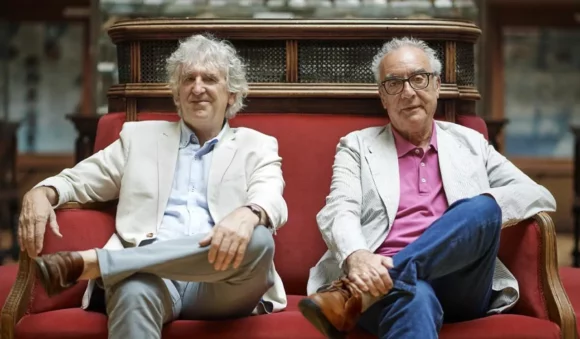In 2013 the oldest known human DNA was discovered, in a complex of caves in the Sierra de Atapuerca in northern Spain. It belongs to an early hominid, Homo heidelbergensis, who lived 400,000 years ago, and to whom we owe the invention of the fireplace.
Arsuaga has built an illustrious career around excavations in Atapuerca, a site humans have occupied continuously for a million years, from the dawn of Homo sapiens to the bronze age. He knows a lot about how humans evolved, and he is an eloquent communicator. “As he talked,” the novelist Juan José Millás recalls, “I realised what a great sense of the theatrical Arsuaga had. He was a master of oral storytelling. He knew when he had his audience, and when he was running the risk of losing them. He endeared himself by combining intellectual precision with a kind of helplessness.”
It’s Aruaga’s eloquence that first persuaded Millás that the two of them should collaborate on a book — a Boswellian confection in which Millás (humble, curious, a klutz, and frequently brow-beaten) follows Arsuaga around with a dictaphone capturing the great man’s observations. “In Spain,” he remarks, early on, “there are two principal periods: the first runs from the Neolithic to 1958, at which point the social planning by the Opus Dei technocrats comes in. Until then, the countryside was a place full of people, full of voices, life here was not a sad thing, there were children running around. It would be like walking down the street. By 1970, the countryside was empty, there was nobody left.”
Millás casts Arsuaga as the representative of Homo sapiens: articulate, eclectic, self-aware and tragical. Millás casts himself as Homo neanderthalis, not quite as quick on the uptake as his more successful cousin. Neanderthals are a species not exactly lost to history (Sapiens and Neanderthals interbred, after all) but no longer active in it, either.
The idea is that Arsuaga the high-brow leads our beetle-browed narrator hither and thither across northern Spain, on foot or in his trusty Nissan Juke, up lost valleys (to understand the evolution of hunting) and through deserted playgrounds (to grasp the mechanics of bipedalism), past market stalls (to grasp the historical significance of diet) and into a sex shop (to discuss the relative size of primate testicles) and building, bit by bit, a dazzling picture of the continuities that exist between our ancient and contemporary selves.
For many, the devil will be in the detail. Take, for example, Millás’s Neanderthals. He is not exactly wrong in what he says about them, but he is writing, in the most general and allusive terms, into a field that is developing frighteningly fast. It‘s hard, then, for us to know how literally to take the author’s showier gestures. Millás says, about that famous interbreeding, that “The Sapiens, being the smart ones, did it out of vice, while the Neanderthals, who were more naïve, did it out of love.” With Neanderthal intelligence and sociality a topic of so much fierce debate, such statements as this may be met with more scepticism than appreciation.
This is as much a buddy story as it is a virtuosic work of popular science. In unpacking our evolutionary past, Millas also brings his human subject to light. Arsuaga holds to the tragic view of life espoused by the fin de siecle Spanish essayist Miguel de Unamuno. Millás, a more common-or-garden depressive, finds Arsuaga’s combination of high spirits and annoyance hard to read. Deposited on the outskirts of Madrid, and half suspecting he’s been actually thrown out of Arsuaga’s Nissan, Millás realises that the palaeontologist “experiences sudden bursts of sadness that he sometimes conceals beneath an ironic demeanour, and sometimes beneath passing bad moods. I think the idea that life is absurd bothers him.”
Aruaga’s tragic sense entends to the species. We are the self-domesticating species: “To the Neanderthal,” he says, “the Sapiens must have seemed like a teddy bear.” We have evolved social complexity by shedding the adult seriousness we observe in less social mammals. (“I’ve been to Rwanda, looking at old gorillas,” says Aruaga, “and I can assure you they don’t play at all, they don’t laugh at anything.”) Over evolutionary time, we have become more playful, more infantile, more docile, and we have done this by executing, imprisoning and marginalising those who exhibit an ever-expending list of what we consider anti-social traits. So inanity will one day conquer all.
I wish Millás was a less precious writer. Very early on the pair arrive at a waterfall. “What had we come here for?” Millás writes: “in principle, to see the waterfall, and perhaps so the waterfall could see us, too.” Such unredeemable LRBisms are, I suppose, a form of protective coloration, necessary for a novelist and poet of some reputation: an earnest of his devotion to propah lirtritchah.
It’s when Millás forgets himself, and erases the distance he meant to maintain between boffins and scribblers, that Life becomes a very special book indeed: a passionate, sympathetic portrait of one life scientist’s world view.

